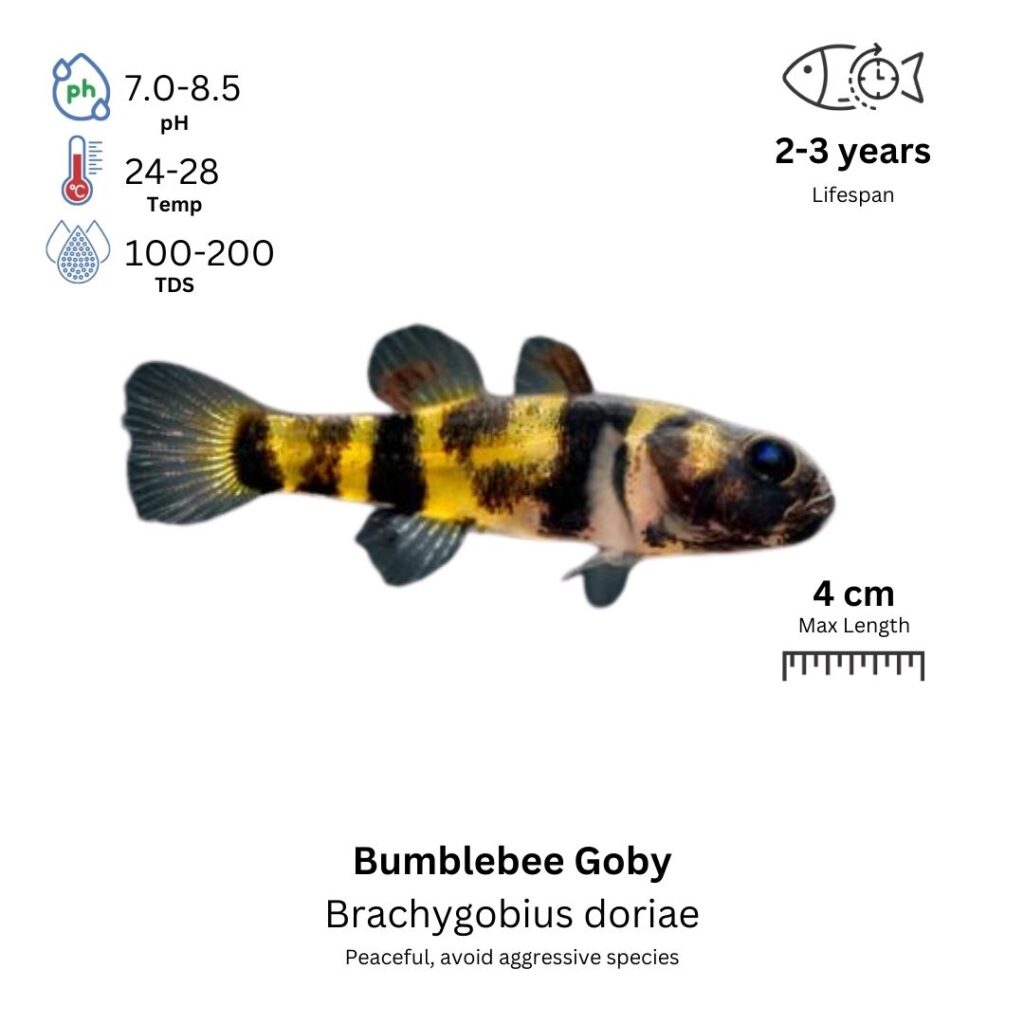Bumblebee Goby
Brachygobius xanthozona

Description
The Bumblebee Goby is a small and attractive species of freshwater goby known for its striking black and yellow coloration, which resembles the pattern of a bumblebee. These fish have a stout, rounded body with horizontal yellow and black stripes running across the body, giving them a distinctive appearance. The stripes often extend onto their fins, further enhancing their bumblebee-like look. They have small, rounded heads with large eyes and are characterized by their sedentary nature, typically staying in one spot for extended periods. These gobies are peaceful, non-aggressive, and enjoy having plenty of hiding spots in the tank. Bumblebee Gobies are bottom dwellers, and they spend most of their time on or near the substrate, where they scavenge for food.
Habitat Origin
Native to Southeast Asia, particularly in Thailand, Vietnam, and parts of Malaysia. Bumblebee Gobies are typically found in brackish waters, such as estuaries, mangroves, and coastal rivers, where freshwater and seawater mix. They prefer shallow waters with slow-moving currents and abundant hiding places among rocks, plants, and debris.
Aquarium
Ideal Number in Aquarium: At least 3-6 individuals, as they are social fish and feel more secure in groups.
Favorite Food

Bumblebee Gobies are omnivores and will eat a variety of foods. They primarily feed on small invertebrates, worms, and detritus in the wild. In captivity, they can be fed high-quality sinking pellets, live or frozen foods such as bloodworms, brine shrimp, and daphnia. They will also accept flake food and small pieces of blanched vegetables like spinach or zucchini. A varied diet is essential for their health and to maintain their vibrant coloration.
Behavior:
Bumblebee Gobies are peaceful, slow-moving fish that spend most of their time near the substrate, often found resting on rocks, plants, or decorations. They are bottom-dwellers and can be somewhat territorial, particularly if there aren’t enough hiding places or territories to claim. Bumblebee Gobies are generally peaceful toward other fish, though males can sometimes exhibit territorial behavior toward each other, especially during breeding periods. They are not active swimmers and prefer staying close to their hiding spots. They are best kept with other small, peaceful species and should not be housed with overly aggressive fish.
Special Care:
Bumblebee Gobies thrive in tanks that replicate their natural habitat, which typically includes brackish water conditions. While they can tolerate fully freshwater setups, they do best in slightly brackish water with a specific gravity of 1.005 – 1.010. It is important to maintain stable water parameters and provide plenty of hiding spots and decorations like rocks, driftwood, and plants. Bumblebee Gobies are not strong swimmers, so they should be housed in tanks without strong currents. Regular water changes and good filtration are important to maintain water quality, as they can be sensitive to poor water conditions.
Compatibility with Other Fish:
Yes, Bumblebee Gobies are compatible with many small, peaceful species. They can be housed with other small, non-aggressive fish like tetras, rasboras, and peaceful catfish. They should be kept with species that occupy different parts of the tank, as Bumblebee Gobies are bottom dwellers. Avoid housing them with large or overly aggressive species, as they may be stressed or become prey. They can coexist with other gobies and shrimp that prefer calm environments and have similar water requirements.
Breeding Setup
Using a dedicated breeding tank is strongly recommended for Bumblebee Gobies due to their territorial nature and need for stable water parameters. A 20-liter (5-gallon) aquarium is adequate for a breeding pair, with options to scale up for multiple pairs. Maintain water conditions at pH 6.5–7.5, temperature 24–28°C (75–82°F), and GH 5–15 dGH. Use a gentle sponge or low-flow internal filter to keep the environment calm. Provide a fine sandy substrate, live plants, and small caves or driftwood for hiding and spawning. Moderate lighting simulates their naturally shaded habitats and supports plant growth.
Conditioning for Breeding
To condition Bumblebee Gobies for spawning, offer a high-protein and varied diet including live foods like brine shrimp, daphnia, bloodworms, and mysis shrimp, along with high-quality sinking pellets. This diet enhances color and readiness for breeding. Conduct regular 25% weekly water changes to keep the environment clean and stable, which is essential for triggering natural spawning behavior and maintaining fish health.
Spawning Process
Bumblebee Gobies are substrate spawners that usually breed in low light periods, such as early morning or late evening. Males exhibit vivid coloration and chase females to initiate courtship. Females lay 20–50 small, sticky eggs in concealed spots such as caves, under driftwood, or on plant surfaces. Once eggs are laid, the male guards the clutch, oxygenating the eggs by fanning them. After spawning, remove the female to prevent aggression and ensure the male can care for the eggs undisturbed.
Fry Care
Eggs hatch in 2–3 days, depending on temperature. Initially, the fry will stay near the nest and rely on their yolk sacs for nourishment. Once they are free-swimming, feed them infusoria or liquid fry food. Within a few days, introduce baby brine shrimp or other microscopic live foods. Gradually transition to finely crushed sinking pellets as they grow. Maintain excellent water quality with 10–15% daily water changes and keep parameters stable within the ideal breeding range.
Important Notes
Bumblebee Gobies reach sexual maturity at 6–8 months. Males are more colorful and have longer fins, while females appear rounder, especially when gravid. During courtship, males intensify their colors to attract mates. To avoid stress and failed breeding, prevent overcrowding, ensure stable water conditions, and avoid aggressive or fast-swimming tankmates. A quiet, secure environment will maximize breeding success and fry survival.
